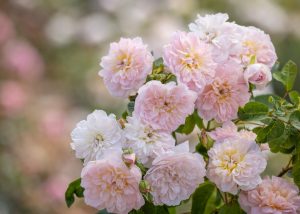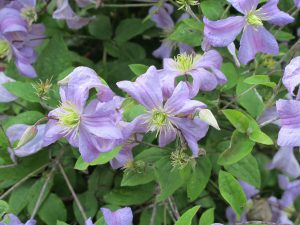
Lots of people in horticulture will have very fond memories of out late Queen Elizabeth, including the staff and management of Hartley Botanic. Her late Majesty adored going to the Chelsea Flower Show and Hartley are regular attendees. I particularly remember her visit in 2012, the year of the Diamond Jubilee, because an entire military band was secreted behind a screen. As soon as she appeared round the corner, they began playing and her face lot up. I think it was Congratulations. Her late Majesty liked the floral pavilion and she always made a beeline for the late Peter Seabrook, another person with a twinkle in his eye. She would also go to Raymond Evison’s clematis stand. I never met our late Queen, but I saw her at close quarters and I can tell you that she shone like a bright light.
In May 2019 the Duchess of Cambridge, now the Princess of Wales, designed a Chelsea Show Garden to indicate that gardening is good for your mental health. I managed to get one of the few Sunday Press Passes. I was sauntering along a quiet path, wearing my red trilby hat, when I became aware of a baby waving at me. As I waved back, I heard a man’s voice say ‘he likes your hat’ and then I realised that it was Prince William carrying Prince Louis. He also liked my jangly silver bracelets, as well! Then I noticed the rest of the family, all heading for their car. The three children were not happy about leaving, because their parents were staying and there was quite. A lot of squawking! These are special moments I will treasure.
It set me thinking about the late Queen’s favourite plants and Lily of the Valley (Convallaria majalis) was said to be her favourite flower. The distinct scent and pristine white bells, framed by a pair of wide green leaves, combine simple freshness and a delicate charm. Underneath though, this is a tough shade-loving woodlander and (if it likes you) it can be very persistent because of its spreading rhizomes. This is probably one of the reasons why the Victorian language of flowers associated trustworthiness with Lily of the Valley. I rather suspect being Queen required the same robust steadfastness, so it is an appropriate choice. It grows well in the garden of Buckingham Palace’s and it was in her Coronation bouquet.

Lily of the Valley is a perfect plant to force into flower in an unheated greenhouse. The price of electricity has forced me have a rethink about heating it as much as I used to, so I’m looking for hardier things to grow.
Lily of the Valley should flower precociously under glass, hopefully by midwinter, and it looks wonderful in a simple pot top-dressed with fresh green moss. You can also force crocuses, scillas and primroses in this way. The garden staff raise all sort of things and, at the beginning of 2022, Her late Majesty was photographed sitting beside a pot of snowdrops.
David Austin launched a new rose in her honour in 2022, naming it ‘Elizabeth’ and it’s doing very well for me! This large shrub rose (4m x 4m) has frilly apple-blossom pink blooms with an old-fashioned quartered shape. The heart of the flower is a warm peachy pink and then the blooms fade to apple-blossom white. The strong, sweet, fresh fragrance has hints of lemon sherbet and old rose, according to David Austin Roses, and they also say that it’s exceptionally healthy. I think this will be planted in her honour in many a garden and it is available as a bare-root plant at this time of year. These are cheaper to buy and cost less to post out and, most important of all, they establish themselves far more readily than a containerised rose in a pot. A very similar rose decorated the late Queen’s coffin, highlighted by dark dahlias and sedums, along with darker-pink roses. I hope the paler rose was ‘Elizabeth’, because I’m sure it’s been planted in the Royal gardens.

The Queen was also fond of sweet peas and white sweet peas from Balmoral featured in one of wreaths placed on the late Queen’s coffin. It might seem a strange time to mention sweet peas, now that the evenings are drawing in, but sweet pea enthusiasts tend to sow their seeds in late October or early November. One of my gardening friends always sows his sweet peas on November 5th or Bonfire Night. The hardest thing of all is keeping the mice away, so use plenty of chicken wire or get a cat! And again, an unheated greenhouse is perfect, because cool temperatures produce better root systems.
My favourite sweet pea varieties are highly scented, frilly and pastel in colour. They epitomise a summer’s day. They must also be good for cutting, so stem length is important. Favourites include the pink and white ‘Gwendoline’, a mid-blue named ‘Our Harry’, the lilac-white ‘Sir Jimmy Shand’, the lavender-blue ‘Charlie’s Angels’ and a creamy-white named ‘Jilly’. I also like the look of the claret-red ‘Seabrook’s Fantasia’ ( available from Kings Seeds. Eagles Sweet Peas have named a new pure-white ‘Platinum Jubilee’ and they also sell a salmon-pink named ‘William and Catherine’. The Duchess of Gloucester is also a sweet pea fan, apparently, and there’s no better cut and come again flower. The more you cut, the more you get.
The first Queen Elizabeth was associated with a clematis known as the Virgin’s Bower, although it’s unclear (to me at least) which species this refers to! It’s not our native old man’s beard, C. vitalba though. This drapes the lanes of Gloucestershire with silky spiders and these persist through winter. It’s strays into gardens when they fluffy seeds fly and I find myself plucking out the seedlings. They seem to choose your best plants, whether it’s a clump of prized trilliums or a special hellebore!

Many clematis have been named after Royal personages, but there’s one that stands out for me and that’s ‘Prince Charles’. This blue-grey, starry clematis was probably a chance seedling found on Alex Keay’s New Zealand nursery in the 1950s. It’s a bit of a mystery, because the flowers are quite large, but there are masses of them. It needs a hard prune every February, like all Group 3 clematis, and I consider it to be a viticella variety because it flowers between July and September. Some nurseries list it under large-flowered, but this type produces a few early summer flowers. ‘Prince Charles’ is very abundant and floriferous. It’s easier to grow than some of the Texensis tulip-flowered types with royal connections. The pink ‘Princess of Wales’, the pink and white ‘Princess Kate’ and the violet-blue ‘Prince William’ are all difficult in my cold garden.
I have a viticella screen of several clematis, planted purely for privacy, on the south-facing edge of the garden. My clematis hedge got the full force of 2022’s heat but those clematis didn’t flag, despite the fact that I didn’t water. Their presence cast shade over parts of the autumn border, preventing the herbaceous plants from drying out. It’s been a royal summer in my garden, in more ways than one!



